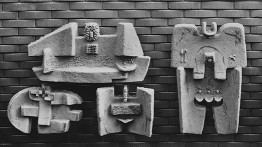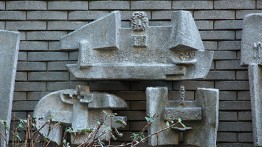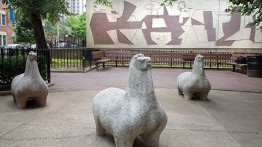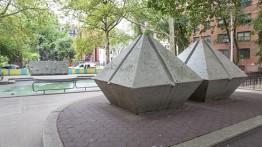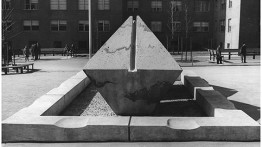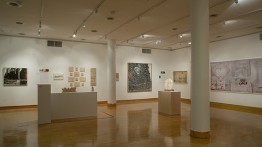Mid-Century Sculptor Costantino Nivola Subject of Houghton Exhibition
POSTED ON: January 17, 2020
PLEASE NOTE: DUE TO THE CLOSURE OF THE FOUNDATION BUILDING OVER THE WEEKEND OF MARCH 14-15, THIS EXHIBITION WILL NOW CLOSE AT 7PM ON FRIDAY, MARCH 13.
Costantino Nivola (1911–88), an artist who made sculptures and murals for public spaces across New York, will be the subject of a new exhibition in the Houghton Gallery, Nivola in New York | Figure in Field, currently open until March 15, 2020.
Mr. Nivola, a native of Sardinia, worked on 22 projects throughout the city, the majority of which were created for public schools. Roger Broome, co-curator of the exhibition and 1990 graduate of The Irwin S. Chanin School of Architecture, notes that while particular themes run throughout the artist's body of work, the New York sculptures and murals "were modified based on the specifics of each commission or problem he worked on. Ultimately, each public work reflected the location it was made for and community it served and became a facet of that place."
A collaborator with some of the best known architects of the era, Mr. Nivola, who was also a prolific painter, constantly explored new methods of making art and thinking about how his pieces would read at different scales. Throughout the exhibition are pieces that demonstrate how he moved from drawings to maquettes to enormous sculptures or murals.
Steven Hillyer, director of the Architecture Archive and co-curator of the exhibition, says he was struck by Mr. Nivola's drive to keep making. "He was remarkably prolific, constantly working," he says. "I was drawn to his understanding of scale and the way he developed techniques that allowed him to jump from the size of a maquette sitting at the edge of his sand-casting field to the scale of a building facade."
The show, which focuses on four of Nivola's projects from around New York, includes an ornamental shield for a vocational high school in Brooklyn and sculptures for a combined police and fire facility on the upper east side. Mr. Hillyer said the Stephen Wise Recreation Area (1963) from 1963 is of particular interest because it includes a grouping of several elements that define a large public space. Taking up a full city block on the Upper West Side, this playground for tenants of a public housing project includes sculptures of abstracted horses, a cast concrete wall with sculptured elements, a fountain made up of two polygons cast with colored sand, and a sgraffito mural—a technique in which the artist carved into a still wet finish coat of cement.
Although most of the works survive today, many are in poor condition. Mr. Hillyer says he's thrilled to have the show here at The Cooper Union both because of the quality of the work and the hope that the exhibition will be instrumental in helping to raise awareness of and ultimately, to preserve Nivola's New York City-based work.
The Nivola family gave the curators unfettered access to their archive, and Carl Stein, AR’68 whose father Richard Stein taught architecture at The Cooper Union from 1946 to 1990, and had worked with Mr. Nivola on numerous projects, advised on the project and lent work for the exhibition. Carl also collaborated with Nivola on the 19th Precinct Combined Police and Fire Facilities project, featured in the gallery. Tom Abraham AR’98 and Ricardo Scofidio AR’55 also lent work. Giuliana Altea and Antonella Camarda of the Costantino Foundation shared their vast knowledge of Nivola and his work as the project developed.
Costantino Nivola worked at the intersection of a host of art and design worlds: in Sardinia, he studied stone masonry with his father before moving to Monza to be work under the architect Giuseppe Pagano and the critic and designer Edoardo Persico. After his studies he became art director of Olivetti’s publicity department by the time he was 25 years old. He called Le Corbusier a mentor and friend, and after moving to the United States in 1939, he collaborated with some of the most important artistic and architectural figures of the 20th century including Bernard Rudofsky, Marcel Breuer, Eero Saarinen, Josep Lluís Sert, among others. Although his work has echoes of the "primitivism" of mid-century American and European art, he created his own symbol system to express ideas with universal resonance for the wide public that would live with his work. Mr. Broome recently pointed out that the artist was fully aware of how the meaning of his art would be affected by its location. That was why, Mr. Broome noted, Nivola used "primary gestures, like the marks of sgraffito, and mythic themes such as motherhood, to connect to a wider audience."
Mr. Broome continued, "Nivola is not a part of the dominant narrative of art history that dictates a hierarchy of values for our culture. He offers something fresh and unfamiliar to those willing to engage his imagination."

